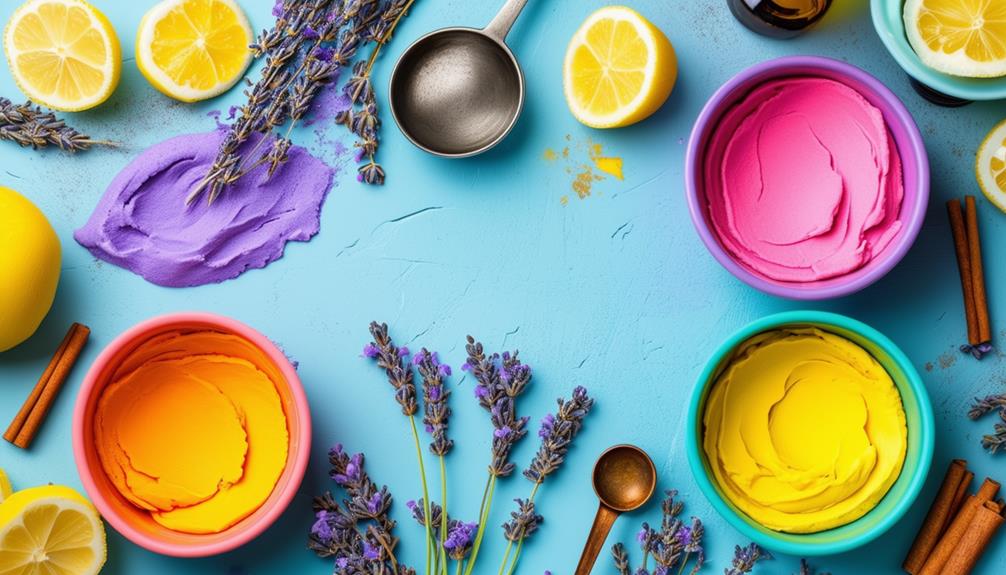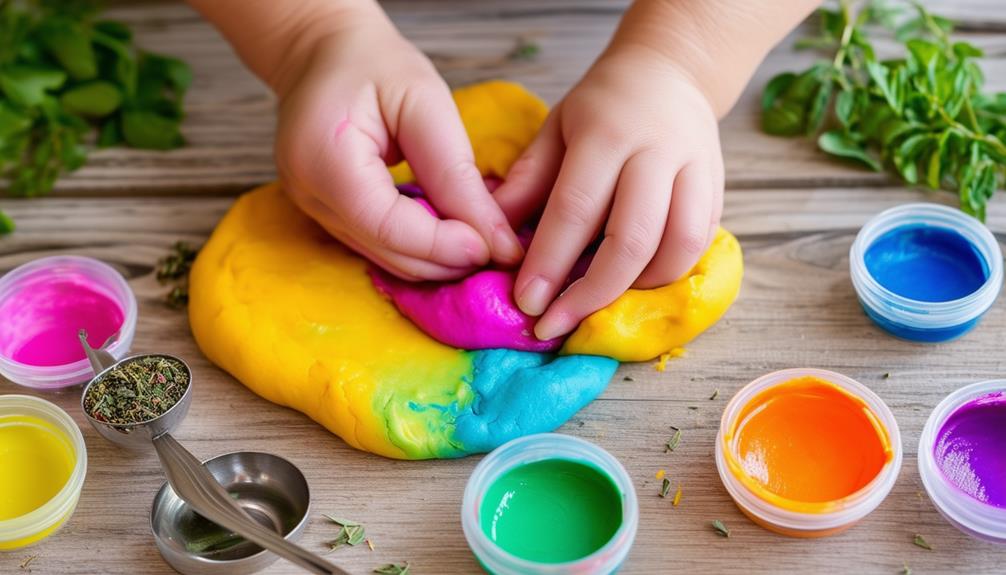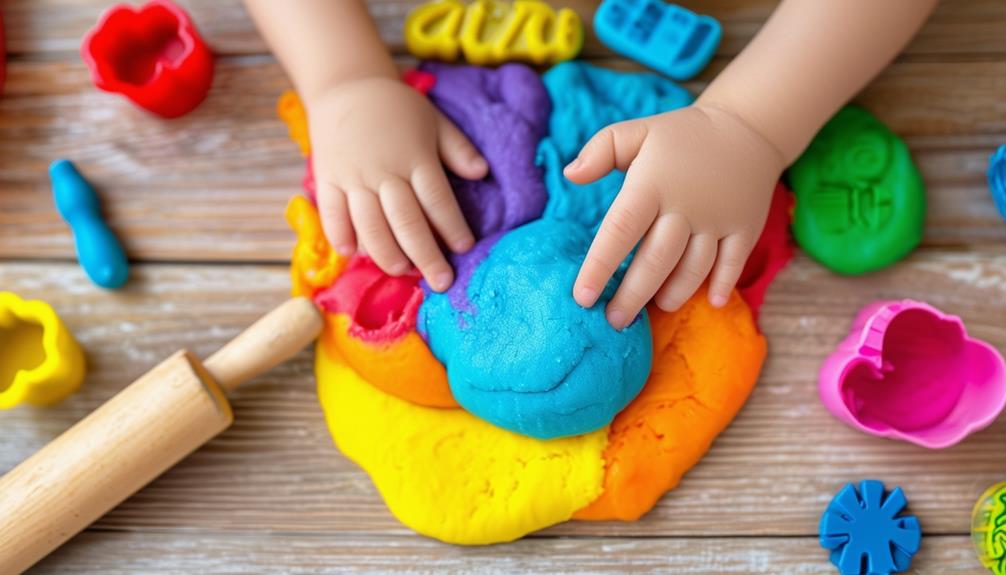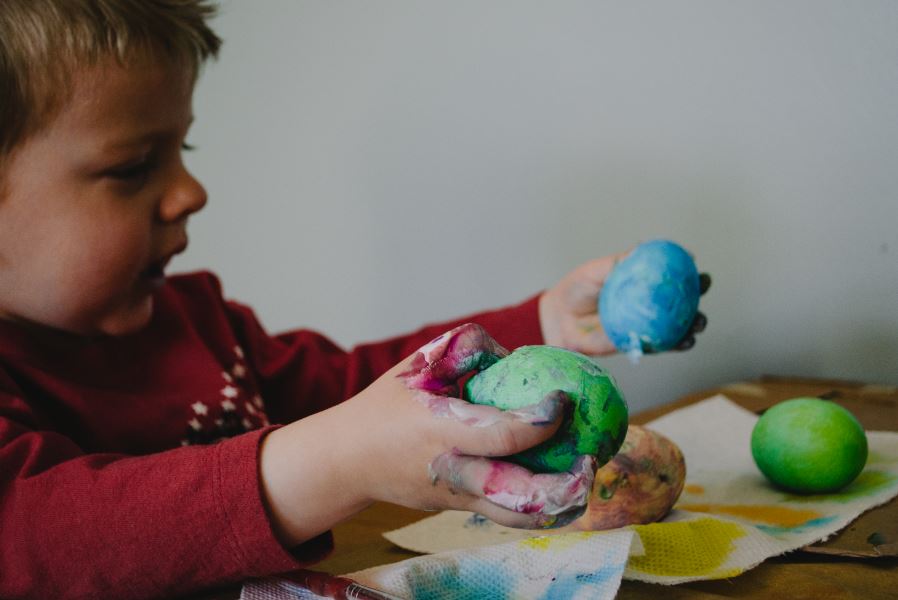How to Make Scented Playdough for Sensory Play

Creating scented playdough for sensory play can enhance a child's experience, making it more engaging and enjoyable. You'll need basic ingredients like flour, salt, water, vegetable oil, food coloring, and essential oils. By combining these components, you can produce a variety of aromatic and visually appealing doughs. The process is straightforward, but customizing the scents and colors is where the real magic happens. Want to know the exact steps and how to solve common problems? Let's explore the key ingredients and step-by-step instructions to get you started.
Benefits of Scented Playdough
Scented playdough enhances sensory play for children and provides aromatherapy benefits with age-appropriate essential oils. Adding such oils creates a multi-sensory experience that can be calming or invigorating. For example, lavender has soothing properties, while peppermint can be uplifting and energizing, making the playdough a tool for emotional well-being.
Customizing the dough with food coloring adds another layer of sensory engagement. Children are drawn to vibrant colors, and you can match the shades to the scents. A calming lavender dough could be a soft purple, while an invigorating peppermint dough might be bright green. This combination of visual and olfactory stimulation enhances the sensory experience, making playtime more enjoyable and beneficial.
Scented playdough is also beneficial for adults. The tactile and aromatic qualities can provide stress relief. Kneading and shaping the dough while inhaling soothing scents can help unwind after a long day. Thus, scented playdough, enhanced with age-appropriate oils, serves as a versatile therapeutic tool for all ages.
Essential Ingredients
To make scented playdough, you'll need essential ingredients like flour, salt, water, vegetable oil, food coloring, and essential oils. You can easily customize the dough's scent and color by mixing different essential oils and food colorings in separate bowls. Plus, it's all kid-safe and non-toxic, ensuring a fun and safe sensory experience.
Basic Ingredients Overview
To create scented playdough, you need essential ingredients such as flour, salt, water, vegetable oil, food coloring, and aromatic oils. These components ensure the playdough is soft, pliable, and engaging through vibrant colors and pleasant scents.
First, combine flour and salt, the fundamental dry ingredients that form the dough's base structure. Add water to bind these dry ingredients into a cohesive mixture. Next, incorporate vegetable oil to enhance moisture and flexibility, making the dough easier to knead and shape.
Food coloring provides vibrant hues, making the playdough visually stimulating and enhancing sensory play. Finally, add aromatic oils like lavender, orange, or chamomile, which not only impart a pleasant aroma but also offer therapeutic benefits, promoting relaxation and well-being during playtime.
Scent and Color Customization
Customize your playdough by blending essential oils like lavender or chamomile and adding vibrant food coloring for a distinct sensory experience. Begin by selecting your preferred essential oils. Lavender, orange, chamomile, pine needle, and rosemary are excellent choices. Add 1-2 drops of essential oil to each batch of playdough to achieve your desired fragrance intensity.
Next, enhance the visual appeal by using food coloring to personalize the playdough's hue. Choose vivid, striking shades or natural coloring alternatives according to your preference. Experiment with different combinations of scents and colors to create a captivating sensory experience.
For example, combining a few drops of lavender essential oil with purple food coloring can produce a soothing playdough, while using orange oil and yellow coloring can create an energizing playdough.
After blending your selected scents and colors, store the playdough in a sealed container to maintain its aroma over time. This way, the playdough remains fresh and ready for sensory play whenever needed. Exploring various scent and color combinations will make each play session unique and immersive.
Kid-Safe and Non-Toxic
Creating child-friendly and non-toxic scented playdough is easy with simple, everyday ingredients. To make your own, you'll need flour, salt, water, vegetable oil, and food coloring. These basic ingredients are harmless and often found in your kitchen. Adding essential oils like lavender, orange, or chamomile can enhance the sensory experience with delightful, soothing scents.
Start by mixing the flour, salt, and water in a bowl. Add a tablespoon of vegetable oil to ensure the dough is soft and pliable. For color, add a few drops of food coloring, stirring until the color is evenly distributed. Finally, introduce a few drops of your chosen essential oil to scent the dough. Essential oils not only provide a pleasant fragrance but are also safe for children in small quantities.
Homemade scented playdough offers a fun and interactive way for kids to explore their senses safely. By using child-friendly and non-toxic ingredients, you can confidently let your children enjoy imaginative play. This DIY project also allows you to customize the playdough to suit your child's preferences, making it a practical and enjoyable activity.
Step-by-Step Instructions

To get started, gather flour, salt, warm water, vegetable oil, and your favorite essential oils. Combine 2 cups of flour and 1 cup of salt in a large mixing bowl. Add 1 cup of warm water and 1 tablespoon of vegetable oil, then mix until the dough starts to form.
Next, add a few drops of food coloring and your selected essential oils for a scented homemade playdough experience. The amount of essential oil will depend on how strong you want the scent to be, but typically, 5-10 drops work well. Continue to mix until the color and scent are evenly distributed.
Knead the dough on a clean surface for about 5 minutes until it's smooth and pliable. This step is vital as it ensures all ingredients are well incorporated. Once you've finished kneading, store the scented playdough in an airtight container to keep it fresh. Now, you're ready to enjoy fun activities with your scented homemade playdough!
Customizing Scents and Colors
Customizing your scented playdough can provide a unique and stimulating sensory experience. Essential oils like lavender, orange, and chamomile can offer either relaxation or energy. Start by adding 1-2 drops of your chosen essential oil per batch of playdough to achieve a subtle yet pleasant aroma.
Experiment with various scents and colors to create new sensory experiences. Peppermint, vanilla, and coconut extracts are also excellent options. Adjust the amount of extract to achieve your desired scent strength, adding a few more drops if you prefer a more potent aroma.
Additionally, you can mix and match food colorings to make your playdough visually appealing. For example, a lavender-scented batch can be colored purple, while an orange-scented dough can be colored orange. This not only enriches the sensory experience but also makes the playdough more engaging for children.
Create multiple batches with different scents and colors to keep things exciting. Customizing your playdough in this way will provide endless opportunities for sensory play, stimulating both the senses of smell and sight.
Tips and Troubleshooting

Mastering the art of crafting scented playdough involves a few straightforward tricks and solutions to common issues. Adjusting the balance of dry ingredients and liquids is key to achieving the perfect texture. For a firmer playdough, add more flour. If it's too dry, incorporate a bit more water. Sometimes, adding food coloring or liquid scents can make the dough too wet; in such cases, simply add more flour until you reach the desired consistency.
Boiling water is essential when mixing your dry ingredients as it helps dissolve everything evenly, creating a smooth dough. When adding scent, start with 1-2 drops of aromatic oils per batch to ensure a pleasant aroma without overwhelming the senses.
Here are a few troubleshooting tips:
- Wet Playdough: If your dough is too sticky, gradually add small amounts of flour until it firms up.
- Dry Playdough: If the dough crumbles or feels too dry, knead in a bit of water until it reaches the right consistency.
- Weak Scent: If the aroma isn't strong enough, add an extra drop of aromatic oil, but be careful not to overdo it.
Storage and Shelf Life
To keep your scented playdough fresh and mold-free, store it in an airtight container or a zip-close bag. This helps maintain its texture and scent, extending its shelf life to approximately 2-3 weeks. Regularly inspect for any signs of mold to ensure it remains safe for use.
Airtight Container Benefits
Storing your scented playdough in an airtight container ensures it stays fresh and prevents drying. After adding fragrant oils, you want that delightful aroma to last. Airtight containers maintain the playdough's texture and scent for weeks.
Sealing your playdough in an airtight container protects it from air, moisture, and other elements that can cause spoilage. This method not only preserves the scent but also extends the playdough's shelf life up to 2-3 weeks, allowing your kids to enjoy their sensory play sessions longer.
Consider these benefits:
- Freshness: Keeps the playdough soft and pliable, ready for fun anytime.
- Extended Shelf Life: Reduces waste by prolonging usability.
- Scent Preservation: Maintains the added fragrance, enhancing the sensory experience.
Using an airtight container is a simple yet effective way to keep your homemade scented playdough in top condition. Your kids will appreciate the longer-lasting fun and consistent, delightful scent every time they play.
Preventing Mold Growth
Airtight containers are crucial for maintaining the freshness and scent of scented playdough, while also serving as your best defense against mold growth. This is particularly important for homemade playdough, which is more susceptible to mold due to its natural ingredients. By storing playdough in airtight containers, you create an environment that inhibits mold spores, thereby extending its shelf life.
To store scented playdough effectively, ensure that the containers are completely sealed. Regularly inspect the playdough for any signs of mold, such as discoloration or an off smell. This is especially important for playdough made with food items, which can be an ideal breeding ground for mold.
With proper storage, scented playdough can remain fresh for about 2-3 weeks. Be vigilant for any changes and discard the playdough if mold is detected. It's safer to make a new batch than to expose children to mold.
Extending Playdough Freshness
To keep your scented playdough fresh, proper storage is essential. Use airtight containers like sealed jars or zip-close bags to maintain its texture and scent. Typically, well-stored playdough lasts about 2-3 weeks.
Here are some effective storage tips:
- Airtight Containers: Store playdough in tightly sealed containers to prevent air exposure.
- Cool, Dry Place: Keep the containers in a cool, dry location to avoid moisture, which can lead to mold.
- Regular Inspections: Periodically check for changes in texture or smell, as these can indicate spoilage.
Given that scented playdough contains flour and salt, regular monitoring is crucial. If you detect mold or an off smell, discard the playdough immediately to avoid health risks. Proper storage ensures a safe and enjoyable sensory experience for children. By following these steps, you can extend the life of your homemade scented playdough, keeping it in excellent condition for as long as possible.




